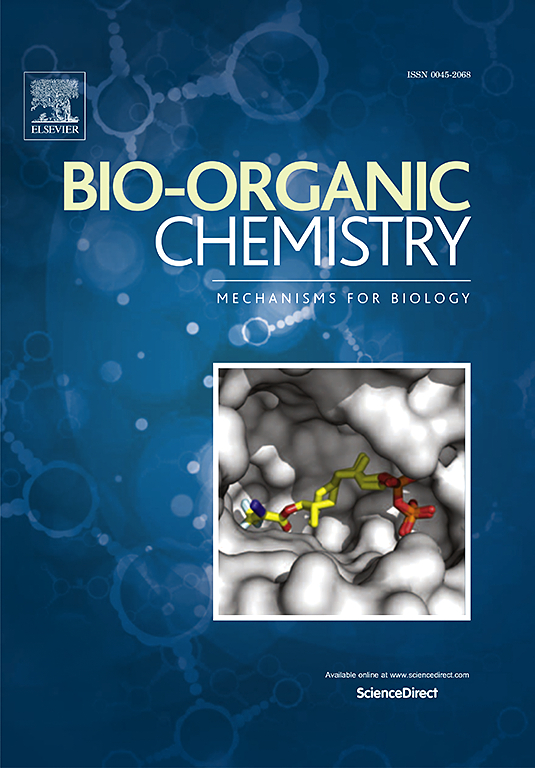Preclinical pharmacokinetics, absolute bioavailability and dose proportionality evaluation of bioactive phytochemical Withanone in rats
IF 4.5
2区 医学
Q1 BIOCHEMISTRY & MOLECULAR BIOLOGY
引用次数: 0
Abstract
Withanone (WN), a bioactive phytochemical isolated from the medicinal herb Withania somnifera, has shown multiple pharmacological and therapeutic successes, including neuroprotective and anti-cancer activities. However, detailed pharmacokinetic (PK) properties of pure WN were not well defined. Pharmacokinetic (PK) characteristics, dose proportionality, and absolute bioavailability of pure WN were explored in rats using an efficient, reliable, and sensitive LC-MS/MS assay to address this gap. The method shows excellent linearity over 0.5–500 ng/mL (r2 ≥ 0.99), is accurate, and requires less analysis time. A dose proportionality and absolute bioavailability of pure WN were determined in Sprague-Dawley (SD) rats through three ascending oral (10, 20, and 40 mg/kg) and single intravenous (5 mg/kg) PK studies. The peak concentration (Cmax) of WN was 60.53 ± 20.33, 116.30 ± 16.89, and 91.62 ± 6.20 ng/mL, corresponding to oral dosage of 10, 20, and 40 mg/kg, respectively. WN shows poor systemic exposure upon oral administration, leading to low oral bioavailability (<15 %). Additionally, the dose proportionality studies of WN revealed its saturable bioavailability and non-proportional systemic exposure over the dosage range of 10–40 mg/kg in rats. The obtained PK findings of this study would be valuable for better understanding the pharmacological effects of WN, dose regimen optimization for future studies, and relevance for clinical reference to support its future development as a potential therapeutic molecule.

生物活性植物化学物威屈酮在大鼠体内的临床前药代动力学、绝对生物利用度和剂量比例评价。
Withanone (WN)是一种从Withania somnifera中草药中分离出来的生物活性植物化学物质,在神经保护和抗癌方面取得了多种药理和治疗成功。然而,纯WN的详细药代动力学(PK)特性没有很好的定义。利用高效、可靠、灵敏的LC-MS/MS方法,研究了纯WN在大鼠体内的药代动力学(PK)特性、剂量比例和绝对生物利用度。该方法在0.5 ~ 500 ng/mL范围内线性良好(r2≥0.99),准确度高,分析时间短。通过三次口服(10、20和40 mg/kg)和单次静脉(5 mg/kg) PK研究,测定纯WN在SD大鼠中的剂量比例和绝对生物利用度。口服剂量为10、20、40 mg/kg时,其峰浓度(Cmax)分别为60.53±20.33、116.30±16.89、91.62±6.20 ng/mL。口服给药后,其全身暴露不良,导致口服生物利用度低(
本文章由计算机程序翻译,如有差异,请以英文原文为准。
求助全文
约1分钟内获得全文
求助全文
来源期刊

Bioorganic Chemistry
生物-生化与分子生物学
CiteScore
9.70
自引率
3.90%
发文量
679
审稿时长
31 days
期刊介绍:
Bioorganic Chemistry publishes research that addresses biological questions at the molecular level, using organic chemistry and principles of physical organic chemistry. The scope of the journal covers a range of topics at the organic chemistry-biology interface, including: enzyme catalysis, biotransformation and enzyme inhibition; nucleic acids chemistry; medicinal chemistry; natural product chemistry, natural product synthesis and natural product biosynthesis; antimicrobial agents; lipid and peptide chemistry; biophysical chemistry; biological probes; bio-orthogonal chemistry and biomimetic chemistry.
For manuscripts dealing with synthetic bioactive compounds, the Journal requires that the molecular target of the compounds described must be known, and must be demonstrated experimentally in the manuscript. For studies involving natural products, if the molecular target is unknown, some data beyond simple cell-based toxicity studies to provide insight into the mechanism of action is required. Studies supported by molecular docking are welcome, but must be supported by experimental data. The Journal does not consider manuscripts that are purely theoretical or computational in nature.
The Journal publishes regular articles, short communications and reviews. Reviews are normally invited by Editors or Editorial Board members. Authors of unsolicited reviews should first contact an Editor or Editorial Board member to determine whether the proposed article is within the scope of the Journal.
 求助内容:
求助内容: 应助结果提醒方式:
应助结果提醒方式:


